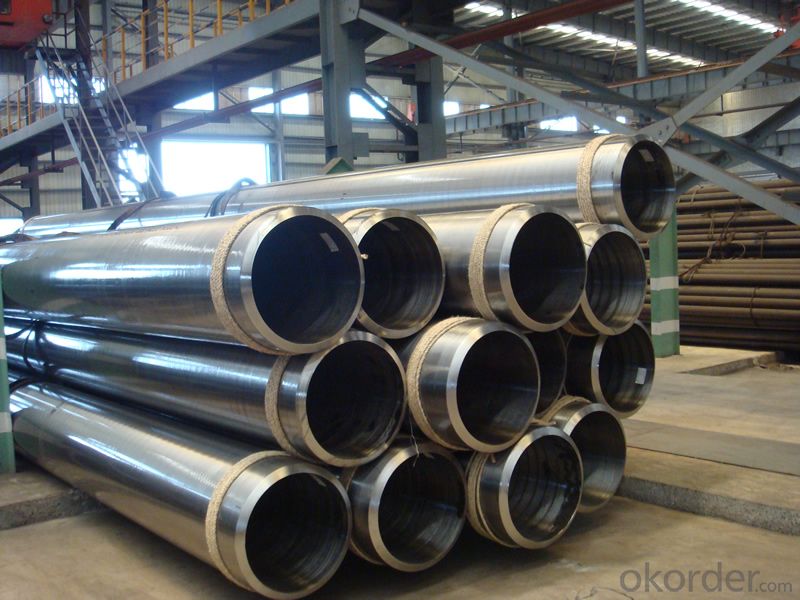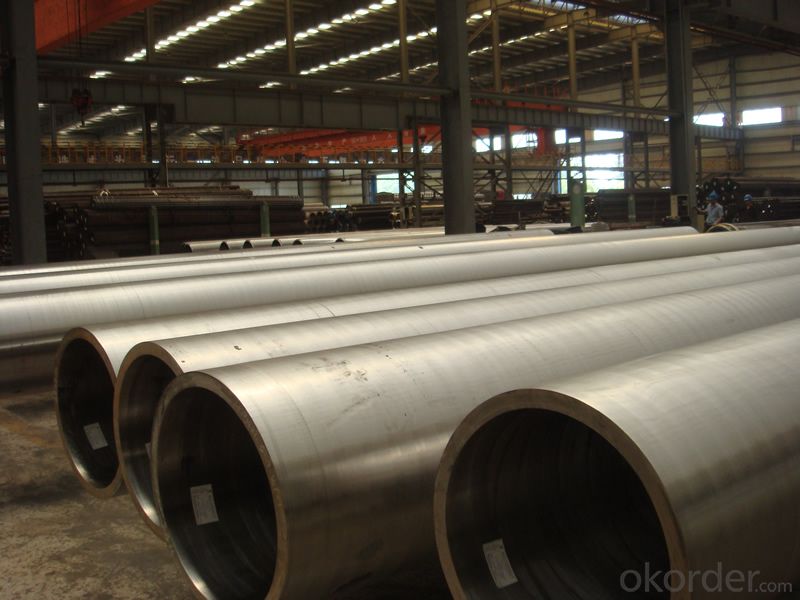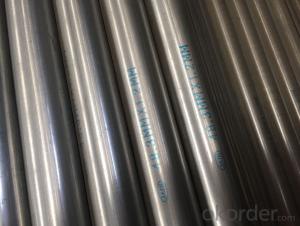Various types of stainless steel pipe waiting for you
- Loading Port:
- Tianjin
- Payment Terms:
- TT OR LC
- Min Order Qty:
- 30 m.t.
- Supply Capability:
- 8000 m.t./month
OKorder Service Pledge
OKorder Financial Service
You Might Also Like
Product Description:
1、Structure of Stainless Steel Welded Pipe ASTM A358/A312/A778 Description:
Stainless steel welded pipe is actually a cover term, covering a wide range of alloy and making them suitable for different attributes that are used in a very wide and large numbers of different industries. Stainless steel pipe is resistant to erosion, highly flexible, powerful, easy to use, and can be done in distinct approaches, which means that more and more stainless steel was used as a construction material for large-scale, high impact buildings. It can be molded, rolling, and it can create amazing shapes to make it perfect, It is used as experimental buildings, The use of steel pipe welding of large stainless steel covers other examples.
2、Main Features of the Stainless Steel Welded Pipe ASTM A358/A312/A778:
• High manufacturing accuracy
• High strength
• Small inertia resistance
• Strong heat dissipation ability
• Good visual effect
•Reasonable price
3、Stainless Steel Welded Pipe ASTM A358/A312/A778 Images:



4、Stainless Steel Welded Pipe ASTM A358/A312/A778 Specification:
Size:
| Outside diameter | Outside | Thickness | ||||
| SCH 5S | SCH 10S | SCH 20S | SCH 40S | |||
| (A) | (B) | mm | mm | mm | mm | mm |
| 350 | 14′ | 355.6 | 3.96 | 4.78 | 7.92 | 11.13 |
| 400 | 16′ | 406.4 | 4.19 | 4.78 | 7.92 | 12.7 |
| 450 | 18′ | 457.2 | 4.19 | 4.78 | 7.92 | 14.27 |
| 500 | 20′ | 508.0 | 4.78 | 5.54 | 9.53 | 15.09 |
| 550 | 22′ | 558.8 | 4.78 | 5.54 | 9.53 | 15.09 |
| 600 | 24′ | 609.6 | 5.54 | 6.35 | 9.53 | 17.48 |
| 650 | 26′ | 660.4 | 5.54 | 7.92 | 12.7 | 17.48 |
| 700 | 28′ | 711.2 | 5.54 | 7.92 | 12.7 | 17.48 |
| 750 | 30′ | 762.0 | 6.35 | 7.92 | 12.7 | 17.48 |
| 800 | 32′ | 812.8 | 7.90 | 12.7 | 17.48 | |
| 850 | 34 | 863.6 | 7.92 | 12.7 | 17.48 | |
| 900 | 36′ | 914.4 | 7.92 | 12.7 | 19.05 | |
| 1000 | 40′ | 1016.0 | 9.53 | |||
Tolerances on dimensions table:
| Standard | Outside(mm) | Thickness(mm) | Length(mm) | |
| ASTM A312 | ≤48.26 | +0.40 -0.80 | +No special provisions(Unspecified)-12.50% | Appoint LengthDefinite cut length+6.40 -0 |
| >48.26~114.30 | +0.80 -0.80 | |||
| >114.30~219.08 | +1.60 -0.80 | |||
| >219.08~457.20 | +2.40 -0.80 | |||
| >457~660 | +3.20/-0.80 | |||
| >660~864 | +4.00/-0.80 | |||
| >864~1219 | +4.48/-0.80 | |||
| JIS G3459 | <30.00 ±0.30≥30.00 ±1.00% | <2.00 ±0.20≥2.00 ±10% | Appoint LengthDefinite cut Length | |
| GB/T 12771 | <13.00 ±0.2013.00~40.00 ±0.30≥40.00 ±0.80% | ≤4.00 +0.50 -0.60>4.00 ±10% | +20.00-0 | |
| EN 10217-7 | D1±1.50% with±0.75mm(min)D2±1.00% with±0.50mm(min)D3±0.75% with±0.30mm(min) D4±0.5% with±0.10mm(min) | T1±15.00% with±0.60mm(min)T2±12.5% with±0.40mm(min)T3±10.00% with±0.20mm(min) T4±7.50% with±0.15mm(min) T5±5.00% with±0.10mm(min) EN ISO 1127 | ≤6000 +5.00 -06000~12000 +10.00 -0 | |
5、FAQ of Stainless Steel Welded Pipe ASTM A358/A312/A778:
①How is the quality of your products?
Our products are manufactured strictly according to national and internaional standard, and we take a test on every pipe before delivered out. If you want see our quality certifications and all kinds of testing report, please just ask us for it.
Guaranteed: If products’ quality don’t accord to discription as we give or the promise before you place order, we promise 100% refund.
②How about price?
Yes, we are factory and be able to give you lowest price below market one, and we have a policy that “ for saving time and absolutely honest business attitude, we quote as lowest as possible for any customer, and discount can be given according to quantity”,if you like bargain and factory price is not low enough as you think, just don’t waste your time.Please trust the quotation we would give you, it is professional one.
③Why should you chose us?
Chose happens because of quality, then price, We can give you both.Additionally, we can also offer professional products inquiry, products knowledge train(for agents), smooth goods delivery, exellent customer solution proposals.Our service formula: good quality+good price+good service=customer’s trust
SGS test is available, customer inspection before shipping is welcome, third party inspection is no problem.
Any question, pls feel free to contact us !
- Q:Can stainless steel pipes be used for irrigation systems?
- Yes, stainless steel pipes can be used for irrigation systems. Stainless steel is a durable and corrosion-resistant material, making it suitable for use in irrigation systems where water exposure is constant. Additionally, stainless steel pipes are known for their longevity and ability to withstand high pressure, making them a reliable choice for irrigation applications.
- Q:How do stainless steel pipes compare to concrete pipes?
- Stainless steel pipes offer several advantages over concrete pipes. Firstly, stainless steel pipes have a higher strength-to-weight ratio, making them lighter and easier to handle during installation. They are also more resistant to corrosion and have a longer lifespan than concrete pipes. Additionally, stainless steel pipes have smoother inner surfaces, enabling better flow rates and reducing the likelihood of blockages. Lastly, stainless steel pipes are more flexible and can withstand temperature variations, making them suitable for a wider range of applications compared to concrete pipes.
- Q:Are stainless steel pipes suitable for oil and gas refineries?
- Yes, stainless steel pipes are suitable for oil and gas refineries. Stainless steel pipes offer excellent corrosion resistance and can withstand high temperatures and pressures, making them ideal for transporting and processing oil and gas in refineries. Additionally, stainless steel pipes are durable and have a long lifespan, which reduces the need for frequent replacements and maintenance.
- Q:How do you clean stainless steel pipes?
- To effectively clean stainless steel pipes, various methods can be employed depending on the extent of dirt or grime present. To begin with, warm water and a mild detergent can be utilized. The detergent should be mixed with water and a soft cloth or sponge can be used to gently wipe the surface of the pipes. It is important to ensure that the wiping motion follows the direction of the grain in order to prevent any scratching of the steel. Following this, the pipes should be thoroughly rinsed with clean water and dried with a clean, lint-free cloth. In cases where the pipes exhibit tougher stains or buildup, a vinegar solution can be employed. Equal parts of vinegar and water should be mixed and the resultant solution can be applied to the pipes. Allowing it to sit for a few minutes will enable the solution to dissolve the stains, after which a soft brush or cloth can be used to gently scrub the pipes. Subsequently, the pipes should be well-rinsed with clean water and thoroughly dried. For more stubborn stains or discoloration, the utilization of a specialized stainless steel cleaner or polish is recommended. The product's instructions should be followed, typically involving its application to the pipes and subsequent rubbing with a soft cloth, once again following the direction of the grain. The pipes must then be rinsed extensively with clean water and completely dried. It should be noted that abrasive cleaners or scrubbing pads must be avoided as they possess the potential to scratch the stainless steel surface. Furthermore, it is advisable to always test any cleaning solution or product on a small, inconspicuous area of the pipes before applying it to the entire surface. This ensures that no damage or discoloration occurs.
- Q:Are stainless steel pipes suitable for chemical processing?
- Indeed, stainless steel pipes are well-suited for chemical processing purposes. Renowned for their exceptional resistance to corrosion, stainless steel pipes prove to be an optimal choice when it comes to managing a wide range of chemicals in various processing industries. These pipes exhibit resistance not only towards organic and inorganic chemicals, but also acids, alkalis, and solvents. Consequently, they can endure high temperatures and pressures, thus demonstrating their aptitude for handling aggressive chemicals and upholding process integrity. Moreover, stainless steel boasts hygienic attributes, as it is impermeable and effortless to clean, thereby ensuring the purity of the chemicals undergoing processing. Furthermore, stainless steel pipes possess an extended lifespan and necessitate minimal maintenance, thus presenting a cost-effective solution for chemical processing applications.
- Q:Advantages and disadvantages of PPR lined stainless steel pipe and PPR aluminium plastic pipe
- 1 、 excellent resistance to temperature and pressurePP-R tube and aluminum layer organic combination, with higher strength and better temperature resistance, pressure resistance performance, more suitable for high temperature hot water field use2, small thermal expansion deformationThe thermal expansion coefficient is small (3 x 10-5m/m - C), similar to metal pipe, avoid the pipe deformation due to temperature changes, reduce the number of free arm compensation for pipe deformation, is ideal for heating and central air-conditioning system.3, light blocking oxygenThe intermediate aluminum layer is insulated from oxygen to avoid the oxidation and corrosion of the metal parts in the heating and central air conditioning system, thus effectively prolonging the service life of the system.
- Q:What is the difference between 2507 and 316 stainless steel pipes?
- The main difference between 2507 and 316 stainless steel pipes lies in their composition and properties. 2507 stainless steel is a super duplex stainless steel, which means it contains a higher content of chromium, nickel, and molybdenum compared to 316 stainless steel. This composition results in enhanced corrosion resistance, particularly in aggressive environments such as seawater or acidic solutions. The high chromium and molybdenum content also provide excellent resistance to pitting and crevice corrosion. On the other hand, 316 stainless steel is an austenitic stainless steel that contains lower amounts of chromium, nickel, and molybdenum compared to 2507. While it still offers good corrosion resistance, it is not as resistant to extreme conditions as 2507 stainless steel. In terms of mechanical properties, 2507 stainless steel has higher strength and toughness compared to 316 stainless steel. This makes it suitable for applications requiring high strength and resistance to stress corrosion cracking. In summary, the key differences between 2507 and 316 stainless steel pipes are their composition, corrosion resistance, and mechanical properties. 2507 stainless steel is a super duplex stainless steel with superior corrosion resistance and higher strength, while 316 stainless steel is an austenitic stainless steel with good corrosion resistance. The choice between the two will depend on the specific application and environment in which the pipes will be used.
- Q:Can stainless steel pipes be fabricated?
- Indeed, it is possible to fabricate stainless steel pipes. Stainless steel possesses remarkable versatility, enabling it to be effortlessly manipulated and formed into different dimensions and configurations. By employing fabrication techniques like cutting, bending, welding, and threading, stainless steel pipes can be tailored to meet specific demands. These pipes find application across a wide range of industries, encompassing construction, automotive, oil and gas, plumbing, and more. The corrosion resistance and durability inherent in stainless steel render it a perfect candidate for fabricating pipes that must endure rigorous environmental circumstances.
- Q:What is the difference between 347 and 347H stainless steel pipes?
- The main difference between 347 and 347H stainless steel pipes lies in their carbon content. 347H has a higher carbon content which provides it with enhanced high-temperature strength and improved resistance to sensitization during welding.
- Q:How much more expensive is 304 stainless steel than 201?
- 304 now it's about 20000 yuan a ton, and 201 is about 15000 tons.
1. Manufacturer Overview |
|
|---|---|
| Location | |
| Year Established | |
| Annual Output Value | |
| Main Markets | |
| Company Certifications | |
2. Manufacturer Certificates |
|
|---|---|
| a) Certification Name | |
| Range | |
| Reference | |
| Validity Period | |
3. Manufacturer Capability |
|
|---|---|
| a)Trade Capacity | |
| Nearest Port | |
| Export Percentage | |
| No.of Employees in Trade Department | |
| Language Spoken: | |
| b)Factory Information | |
| Factory Size: | |
| No. of Production Lines | |
| Contract Manufacturing | |
| Product Price Range | |
Send your message to us
Various types of stainless steel pipe waiting for you
- Loading Port:
- Tianjin
- Payment Terms:
- TT OR LC
- Min Order Qty:
- 30 m.t.
- Supply Capability:
- 8000 m.t./month
OKorder Service Pledge
OKorder Financial Service
Similar products
New products
Hot products
Hot Searches
Related keywords


























